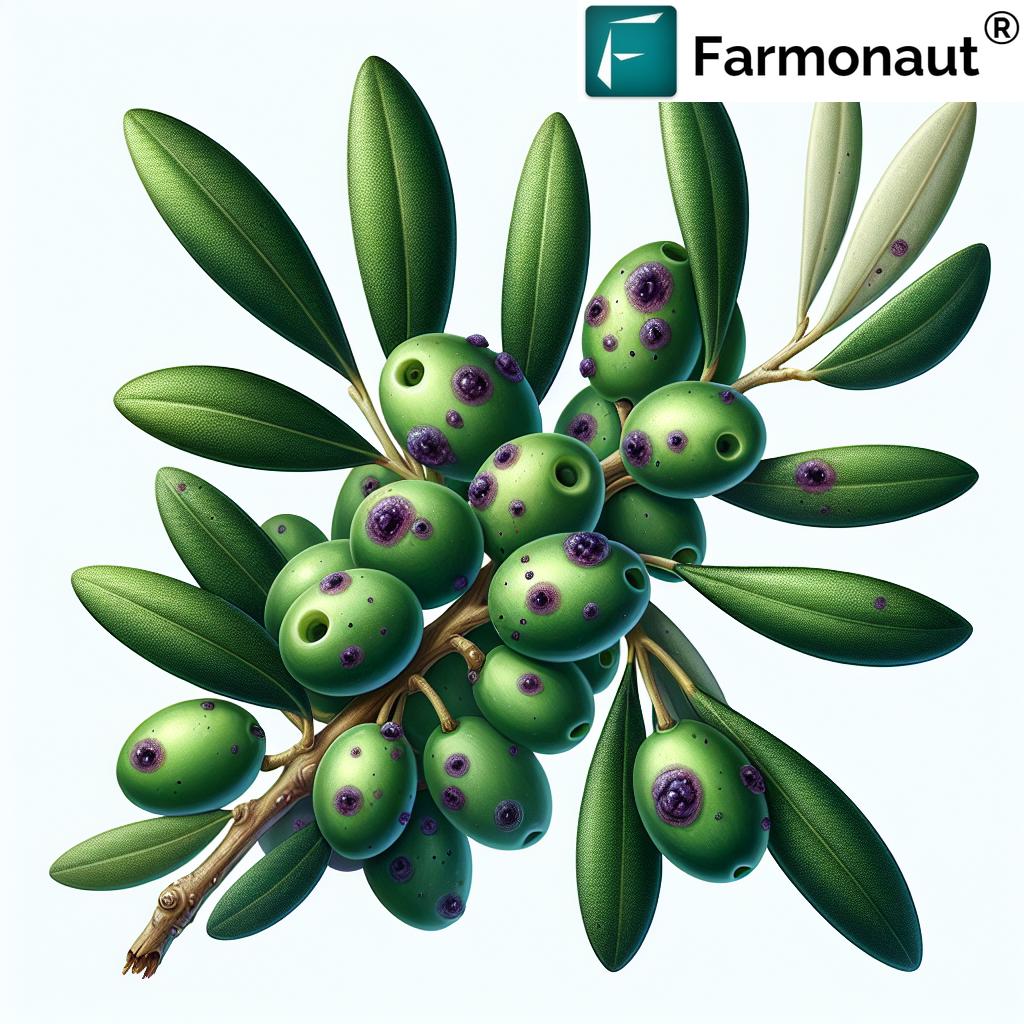Effective Organic and Chemical Treatments to Control Botrytis Cinerea Plant Disease in Crops

In the ever-evolving world of agriculture, one of the most persistent challenges faced by farmers worldwide is the management of plant diseases. Among these, Botrytis cinerea, commonly known as gray mold, stands out as a particularly troublesome fungal pathogen. This ubiquitous disease affects a wide range of crops, causing significant economic losses and posing a serious threat to food security. In this comprehensive guide, we at Farmonaut will delve deep into the world of Botrytis cinerea, exploring its lifecycle, impact on crops, and most importantly, the effective organic and chemical treatments available to control its spread.
Understanding Botrytis Cinerea: The Gray Mold Menace
Botrytis cinerea is a necrotrophic fungus that thrives in cool, humid conditions. It’s known for its ability to infect over 200 plant species, making it one of the most versatile and destructive plant pathogens in agriculture. The disease it causes is often referred to as “gray mold” due to the characteristic fuzzy gray growth that appears on infected plant tissues.
Life Cycle of Botrytis Cinerea
Understanding the life cycle of Botrytis cinerea is crucial for developing effective control strategies. The fungus progresses through several stages:
- Spore Production: The fungus produces spores (conidia) on infected plant tissues.
- Spore Dispersal: These spores are dispersed by wind, water, or insects to new host plants.
- Germination: Under favorable conditions (high humidity and cool temperatures), the spores germinate on plant surfaces.
- Penetration: The fungus penetrates plant tissues, often through wounds or natural openings.
- Colonization: Once inside, the fungus colonizes plant tissues, causing cell death and tissue breakdown.
- Symptom Development: Infected areas develop characteristic gray, fuzzy mold growth.
- New Spore Production: The cycle continues as new spores are produced on infected tissues.
Impact on Crops
The impact of Botrytis cinerea on crops can be devastating. Some of the key effects include:
- Reduced crop yield
- Decreased quality of harvested produce
- Post-harvest losses during storage and transportation
- Increased production costs due to necessary control measures
- Potential development of fungicide resistance
Conventional Detection Methods vs. Farmonaut’s Satellite-Based Approach
Before we dive into treatment options, it’s crucial to understand how Botrytis cinerea is detected in crops. Traditional methods have their place, but modern technology is revolutionizing disease detection. Let’s compare conventional methods with Farmonaut’s innovative satellite-based approach:
| Detection Method | Speed | Accuracy | Cost-effectiveness | Early Warning Capability |
|---|---|---|---|---|
| Visual Inspection | Slow | Moderate | Low | Limited |
| Lab Testing | Slow | High | Low | Limited |
| Farmonaut Satellite System | Fast | High | High | Excellent |
As you can see, Farmonaut’s satellite-based system offers significant advantages in early detection, large-scale monitoring, and cost-efficiency for proactive disease management. By leveraging advanced satellite imagery and AI algorithms, we can detect subtle changes in crop health that may indicate the presence of Botrytis cinerea long before visible symptoms appear.
Organic Treatments for Botrytis Cinerea
In the realm of organic farming and for those seeking environmentally friendly solutions, several organic treatments have shown promise in controlling Botrytis cinerea:
1. Cultural Practices
- Proper Spacing: Ensuring adequate spacing between plants improves air circulation, reducing humidity and creating less favorable conditions for fungal growth.
- Pruning and Trellising: Regular pruning and proper trellising, especially in vine crops, can improve air flow and reduce moisture retention on plant surfaces.
- Sanitation: Removing infected plant debris from the field is crucial as Botrytis cinerea can survive on plant residues.
- Crop Rotation: Implementing a crop rotation strategy can help break the disease cycle by depriving the pathogen of suitable hosts.
2. Biological Control Agents
Several beneficial microorganisms have shown antagonistic effects against Botrytis cinerea:
- Trichoderma spp.: These fungi can parasitize Botrytis cinerea and compete for nutrients and space.
- Bacillus subtilis: This bacterium produces antifungal compounds that inhibit the growth of Botrytis cinerea.
- Gliocladium roseum: Another fungus that has shown promise in controlling gray mold.
3. Plant Extracts and Essential Oils
Certain plant-derived compounds have demonstrated antifungal properties against Botrytis cinerea:
- Garlic Extract: Contains allicin, which has potent antifungal properties.
- Neem Oil: Exhibits both antifungal and insecticidal properties.
- Tea Tree Oil: Has shown efficacy in inhibiting spore germination of Botrytis cinerea.
4. Compost Teas
Properly prepared compost teas can introduce beneficial microorganisms to the plant surface, creating a competitive environment that inhibits pathogen growth.
5. Silicon-based Treatments
Foliar applications of silicon have been shown to strengthen plant cell walls, making them more resistant to fungal penetration.
Chemical Treatments for Botrytis Cinerea
While organic methods are gaining popularity, chemical fungicides remain a crucial tool in managing Botrytis cinerea, especially in severe outbreaks or high-value crops. However, it’s important to use these judiciously to prevent the development of fungicide resistance.
1. Contact Fungicides
These fungicides work by creating a protective barrier on plant surfaces:
- Chlorothalonil: A broad-spectrum fungicide effective against many fungal diseases including Botrytis cinerea.
- Mancozeb: Another multi-site fungicide that disrupts several cellular processes in fungi.
- Captan: Effective in preventing spore germination on plant surfaces.
2. Systemic Fungicides
These fungicides are absorbed by the plant and can protect new growth:
- Boscalid: Inhibits fungal respiration and energy production.
- Fludioxonil: Interferes with osmotic signal transduction in fungal cells.
- Iprodione: Disrupts fungal cell division and growth.
3. Combination Products
Many commercial fungicides combine different active ingredients to provide broader protection and reduce the risk of resistance development:
- Pyraclostrobin + Boscalid: Combines two modes of action for enhanced efficacy.
- Fenhexamid + Tebuconazole: Another dual-action fungicide effective against Botrytis cinerea.
4. Resistance Management
To prevent the development of fungicide resistance, it’s crucial to:
- Rotate fungicides with different modes of action
- Adhere to recommended application rates and timing
- Integrate chemical control with other management practices
Integrated Approach to Botrytis Cinerea Management
At Farmonaut, we advocate for an integrated approach to managing Botrytis cinerea. This strategy combines various control methods to achieve optimal disease management while minimizing environmental impact and the risk of resistance development.
Key Components of Integrated Management:
- Monitoring and Early Detection: Utilizing Farmonaut’s satellite-based crop monitoring system to detect early signs of disease.
- Cultural Practices: Implementing proper spacing, pruning, and sanitation measures.
- Biological Control: Incorporating beneficial microorganisms into the management plan.
- Organic Treatments: Using plant extracts and compost teas as preventive measures.
- Chemical Control: Judicious use of fungicides when necessary, following resistance management guidelines.
- Environmental Management: Controlling humidity and temperature in greenhouses or protected cultivation.
- Post-harvest Management: Implementing proper storage and handling practices to prevent post-harvest losses.
The Role of Technology in Botrytis Cinerea Management
As we advance in the fight against Botrytis cinerea, technology plays an increasingly crucial role. At Farmonaut, we’re at the forefront of this technological revolution in agriculture.
Satellite-Based Crop Monitoring
Our satellite-based crop monitoring system provides farmers with invaluable insights:
- Early Detection: Identify potential disease outbreaks before visible symptoms appear.
- Large-Scale Monitoring: Efficiently monitor vast agricultural areas.
- Precision Application: Target treatments to specific areas, reducing overall fungicide use.
To experience the power of satellite-based crop monitoring, try our app today.
Weather Forecasting and Disease Prediction
Accurate weather forecasting is crucial for predicting disease outbreaks. Our Farmonaut Satellite Weather API provides precise, field-specific weather data, enabling farmers to anticipate conditions favorable for Botrytis cinerea development and take preventive action.
Mobile Applications for On-the-Go Management
Our mobile apps for Android and iOS put the power of satellite-based crop monitoring in farmers’ pockets, allowing for real-time decision-making in the field.
Case Studies: Successful Management of Botrytis Cinerea
While we don’t include specific case studies, our experience has shown that farmers who adopt an integrated approach, leveraging both traditional methods and modern technology, have seen significant improvements in managing Botrytis cinerea. These success stories typically involve:
- Reduced fungicide usage
- Improved crop yields
- Better quality produce
- Lower overall management costs
The Future of Botrytis Cinerea Management
As we look to the future, several exciting developments are on the horizon:
- Genetic Resistance: Development of crop varieties with enhanced resistance to Botrytis cinerea.
- Novel Biological Control Agents: Discovery and development of new, more effective antagonistic microorganisms.
- Advanced AI and Machine Learning: Improving disease prediction and early detection capabilities.
- Nanotechnology: Development of nanoparticle-based fungicides for more targeted and efficient disease control.
Conclusion
Managing Botrytis cinerea is a complex challenge that requires a multi-faceted approach. By combining traditional agricultural practices with cutting-edge technology, we can significantly improve our ability to control this devastating plant pathogen. At Farmonaut, we’re committed to providing farmers with the tools and knowledge they need to effectively manage Botrytis cinerea and other crop diseases.
Remember, successful disease management starts with early detection and informed decision-making. Our satellite-based crop monitoring system, weather forecasting API, and mobile applications are designed to give you the edge in the fight against Botrytis cinerea.
Ready to take your crop management to the next level? Subscribe to Farmonaut today and join the future of agriculture:
FAQs About Botrytis Cinerea Management
-
Q: What crops are most susceptible to Botrytis cinerea?
A: Botrytis cinerea affects a wide range of crops, but it’s particularly problematic in grapes, strawberries, tomatoes, and ornamental plants. -
Q: How can I tell if my crops are infected with Botrytis cinerea?
A: Look for gray, fuzzy mold on plant tissues, especially on fruits and flowers. Other symptoms include water-soaked lesions and soft rot. -
Q: Are organic treatments as effective as chemical fungicides against Botrytis cinerea?
A: Organic treatments can be effective, especially when used preventively and as part of an integrated management approach. However, in severe outbreaks, chemical fungicides may provide more rapid control. -
Q: How often should I apply fungicides to control Botrytis cinerea?
A: The frequency of fungicide applications depends on various factors including crop type, weather conditions, and disease pressure. Always follow label instructions and consult with a local agricultural expert. -
Q: Can Farmonaut’s satellite monitoring system detect Botrytis cinerea before visible symptoms appear?
A: Yes, our system can detect subtle changes in crop health that may indicate the early stages of infection, allowing for proactive management.

For more information on our satellite-based crop monitoring system and how it can help you manage Botrytis cinerea and other plant diseases, visit our API documentation or contact our support team.









